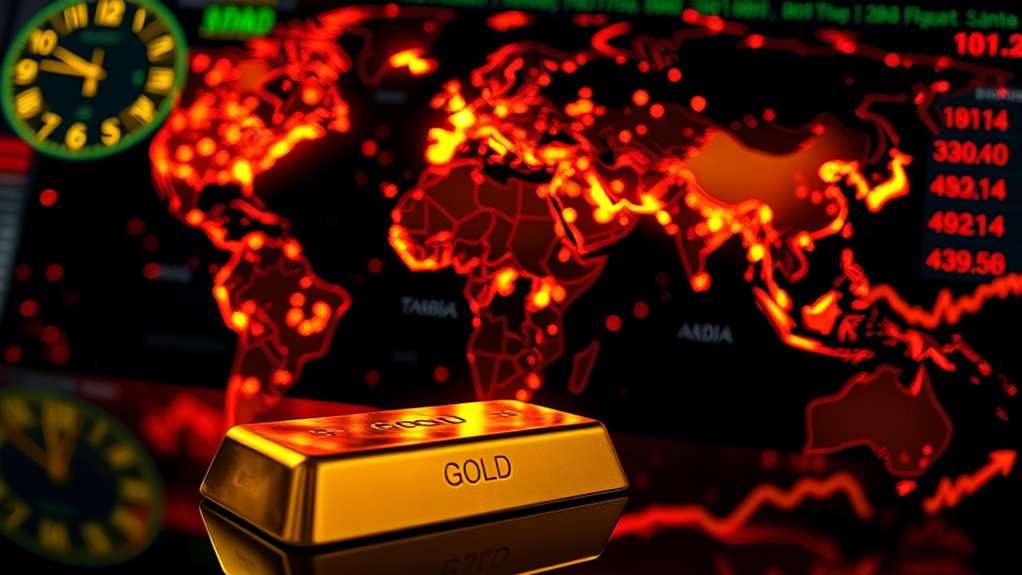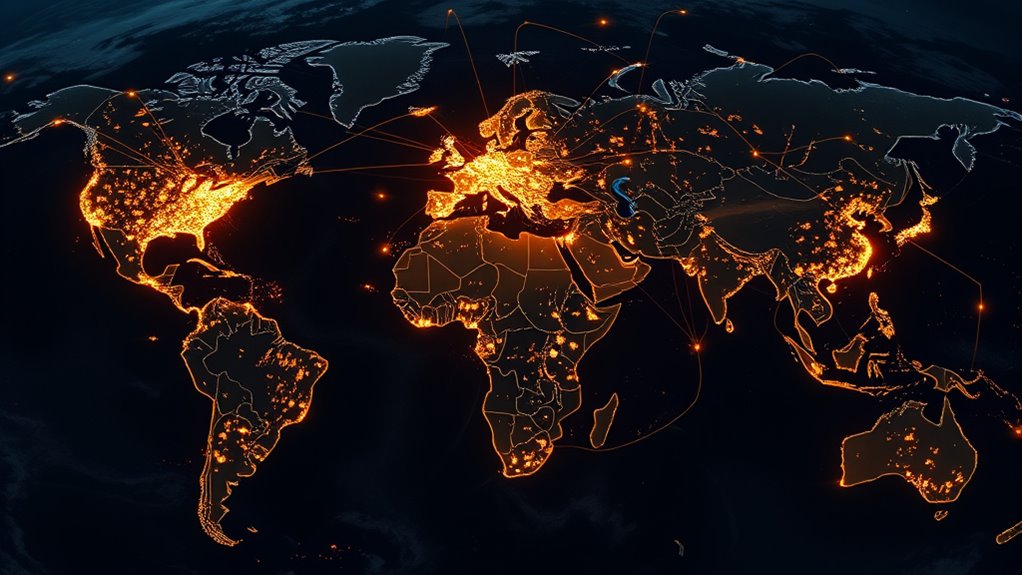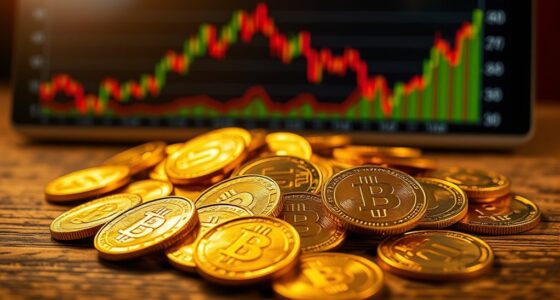Over the past 50 years, geopolitical hotspots like wars, invasions, and regional conflicts have repeatedly caused sharp gold price shocks, as investors seek safety during turbulent times. Crises such as the 1973 oil crisis, Soviet invasion of Afghanistan, and recent Russia-Ukraine tensions all triggered significant gains in gold. These events highlight how geopolitical unrest drives gold’s safe-haven appeal, making it an essential asset in volatile periods. Continue exploring to see how these patterns can help you anticipate future gold price movements.
Key Takeaways
- Historical crises like the 1973 Oil Crisis and 1979 Soviet invasion caused gold prices to triple or surge significantly.
- Gold acts as a safe haven, with demand and prices rising during geopolitical conflicts and regional tensions.
- Gold prices often increase before conflicts due to market anticipation, then stabilize or decline once events unfold.
- During crises, gold’s relationship with the US Dollar weakens as global demand drives prices independently of currency movements.
- Long-term data shows sustained gold price spikes during major geopolitical events, highlighting its role as a risk hedge.

Geopolitical hotspots often trigger sharp fluctuations in gold prices, as investors seek safe havens amid uncertainty. Over the past 50 years, major conflicts and regional crises have repeatedly demonstrated gold’s role as a reliable refuge during turbulent times. For example, during the 1973 Oil Crisis, gold prices tripled, reflecting how energy-related conflicts can cause significant market upheaval. Similarly, the 1979 Soviet invasion of Afghanistan led to a 66% surge in gold, pushing prices to about $850 per ounce in early 1980. These episodes reveal how geopolitical instability, especially when tied to energy supplies or regional power struggles, can dramatically boost demand for gold. When Iraq invaded Kuwait in 1990, gold prices rose by around 15% within just two months, illustrating how tensions in the Middle East directly influence safe-haven flows. Even more recent crises, like the September 11 attacks in 2001, prompted a swift 6% spike as markets scrambled for stability amid fears of broader conflict. The annexation of Crimea by Russia in 2014 also triggered a 14% increase, showing that regional conflicts in Eastern Europe can shake investor confidence and drive gold demand.
As you observe these patterns, it’s clear that geopolitical risks inject unpredictability into financial markets, pushing investors toward gold as a risk-averse asset. During wars, revolutions, sanctions, or political upheavals, demand for gold surges because it’s perceived as a safe store of value that isn’t tied to any single currency or government. Central banks often increase their gold reserves during crises to hedge against both geopolitical uncertainty and the depreciation of their national currencies. For instance, in times of heightened tension, especially when energy supplies or trade routes are threatened, gold becomes even more attractive. The ongoing Russia-Ukraine conflict, for example, has amplified gold demand amid rising inflation and market volatility, reaffirming gold’s status as a hedge during complex geopolitical crises. Historical data shows that geopolitical crises tend to increase demand for gold, leading to price spikes that can last for months or even years. Additionally, understanding the relationship between gold and currency can help investors better interpret market reactions during times of turmoil. You’ll notice that gold’s response to geopolitical events often follows a pattern of “buy the rumor, sell the news.” Before military actions, gold tends to climb as markets anticipate conflict, but once the event unfolds, prices sometimes decline as the initial uncertainty resolves. This speculative pattern underscores the importance of timing and expectations in short-term gold price movements. Recognizing the inverse relationship between gold and the US Dollar Index is crucial, as it often influences how gold reacts during crises. During major crises, this inverse relationship can weaken as global demand for gold surges, decoupling currency and bullion movements. Recognizing the role of safe-haven assets is crucial, as it often determines the magnitude of gold price shifts during times of crisis. Overall, understanding these historical patterns and relationships helps you better anticipate how geopolitical risks can influence gold’s trajectory, making it a vital tool for steering through market volatility during times of global unrest.
Frequently Asked Questions
How Do Minor Geopolitical Events Influence Gold Prices?
Minor geopolitical events cause quick, short-term gold price spikes because you see increased investor fear and risk perception. When tensions rise, you tend to buy gold as a safe haven, pushing prices up around 1-5%. These moves are often driven by media coverage, diplomatic signals, and regional fears. You’ll notice prices usually return to normal soon after, but during these moments, gold acts as your safe escape during uncertainty.
Are There Regional Differences in Gold Price Reactions to Crises?
Did you know that Middle Eastern conflicts can cause gold prices to jump by over 20% in just weeks? Regional differences are clear: in the Middle East, tensions trigger rapid, sharp increases due to energy significance and military fears. Latin America sees more gradual rises tied to political unrest, while Eastern Europe’s conflicts cause persistent price hikes driven by energy and security concerns. You’ll notice that regional factors influence both the timing and magnitude of gold’s response.
How Do Central Bank Policies Affect Gold During Geopolitical Tensions?
You see, central bank policies play a crucial role in gold’s behavior during geopolitical tensions. When central banks buy more gold, they create a strong price support, even if Fed policies tighten. Their demand signals confidence in gold as a reserve, boosting prices. Conversely, if central banks reduce purchases, gold might weaken. So, their actions directly influence gold’s resilience amid geopolitical crises, making it a essential safe-haven asset.
What Role Do Currency Fluctuations Play in Gold Price Shocks?
You should understand that currency fluctuations directly impact gold prices. When a currency, especially the US dollar, weakens, gold becomes cheaper for international buyers, pushing prices higher. Conversely, a strong dollar makes gold more expensive and can suppress demand. During economic uncertainty or crises, currency volatility often triggers sharp gold price swings as investors seek safe-haven assets, amplifying the effects of these fluctuations on gold’s value.
Can Geopolitical Hotspots Predict Long-Term Gold Price Trends?
Have you considered whether ongoing conflicts signal lasting gold price growth? Geopolitical hotspots are strong predictors of long-term trends because they reflect sustained uncertainty and risk, which drive demand for safe-haven assets like gold. When tensions escalate, demand often stays high, pushing prices upward over time. So, if you’re looking to anticipate future gold movements, keep an eye on geopolitical developments—they can reveal more than just short-term spikes.
Conclusion
So, next time geopolitical tensions rise, don’t dismiss gold as just another safe haven. Our 50-year data shows that gold often reacts sharply to such hotspots, offering you a hedge against instability. You might think these shocks are unpredictable, but history proves otherwise. By staying informed and prepared, you can better protect your investments—gold isn’t just a fallback; it’s a strategic asset during uncertain times.









